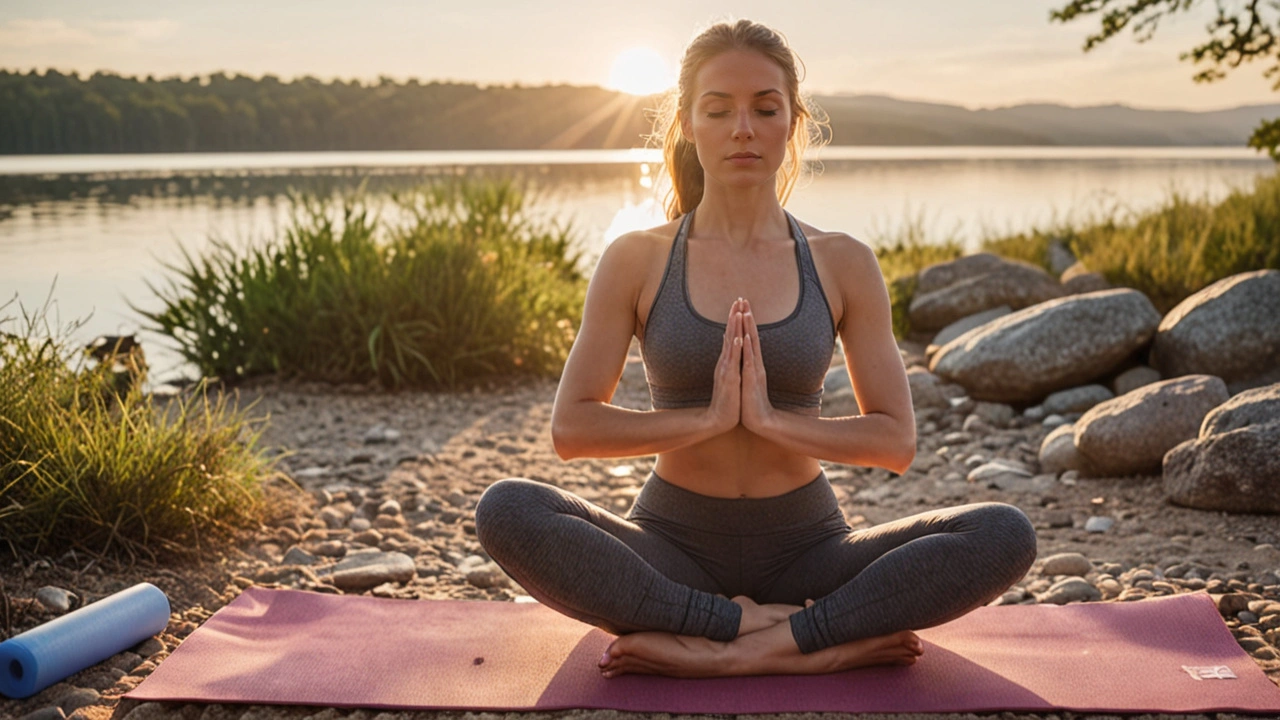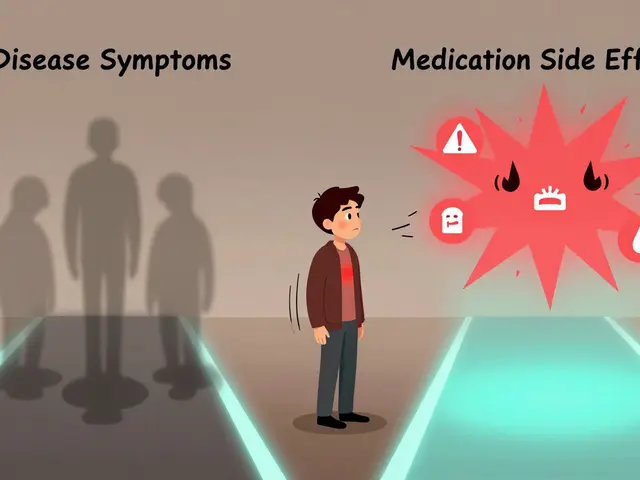
Muscle aches are a common struggle, whether you're a weekend warrior or someone with a desk job. The discomfort can range from mild stiffness to debilitating pain. Interestingly, mindfulness meditation offers a natural and effective approach to managing these aches.
Unlike conventional methods like medication or physical therapy, mindfulness tackles pain from a different angle. It’s not just about relieving symptoms but also about changing the way you perceive and respond to pain. This holistic approach not only helps in reducing muscle aches but also enhances one’s overall well-being.
By practicing mindfulness, you can develop a greater awareness of your body. This increased awareness leads to better stress management and helps in reducing muscle tension naturally. What's more, getting started with meditation doesn't require fancy equipment or extensive training; it only takes a few minutes a day.
Ready to explore how mindfulness can help in your battle against muscle aches? This article dives deep into understanding muscle discomfort, the science behind meditation’s impact on pain, and practical steps to incorporate mindfulness into your daily routine.
- Understanding Muscle Aches
- The Power of Meditation
- How Mindfulness Eases Pain
- Practical Meditation Tips
- Success Stories
Understanding Muscle Aches
Muscle aches, also known as myalgia, are a common experience for many people. They can result from a variety of causes ranging from strenuous physical activity to seemingly innocuous everyday activities. Typically, muscle pain involves a sensation of stiffness, soreness, or even a throbbing feeling. This discomfort can significantly impact daily life, making normal activities a challenge.
One key factor in muscle aches is delayed onset muscle soreness (DOMS), which often occurs after intense or new physical exercises. DOMS usually begins within 12 to 24 hours post-exercise and peaks around the 48-hour mark. This is because unfamiliar physical activities cause microscopic damage to muscle fibers, leading to inflammation and subsequent pain.
Another common cause of muscle aches is stress. Stress induces tension in the body, and this tension can accumulate in muscles, particularly in areas like the neck, shoulders, and back. This condition is often referred to as tension myositis syndrome. Over time, unrelieved stress and tension can lead to chronic muscle pain.
Beyond physical exertion and stress, muscle pain can also stem from medical conditions such as fibromyalgia, which causes widespread musculoskeletal pain. According to Mayo Clinic, fibromyalgia affects about 2% of people, commonly women. This condition amplifies pain sensations by affecting the way the brain processes pain signals.
Mary Ann Wilmarth, spokesperson for the American Physical Therapy Association, states, 'Understanding the root cause of muscle pain is essential for effective treatment. Sometimes, the pain isn't just about the muscle itself but how our body and mind interact.'
In our increasingly sedentary lives, poor posture, particularly from prolonged sitting, also contributes to muscle pain. Sitting for long periods can cause muscles in the back and legs to tighten and weaken, leading to muscle strain and pain. Numerous studies suggest that incorporating regular movement and correct posture can mitigate these issues.
In understanding muscle pain, it's crucial to recognize the role of both physical and emotional well-being. Addressing muscle aches often involves a holistic approach that considers lifestyle choices, physical activity levels, stress management techniques, and sometimes medical interventions. This comprehensive view can help alleviate pain and improve quality of life.
The Power of Meditation
Meditation has long been celebrated for its mental health benefits, but its potential to alleviate physical pain is just as noteworthy. At its core, meditation is about achieving a focused state of mind, promoting relaxation, and gaining a heightened awareness of the present moment. This practice not only calms the mind but also positively affects the body’s stress response, which is a key player in muscle tension and pain.
One of the most compelling aspects of meditation is its ability to influence pain perception. Research has shown that mindfulness meditation can reduce the brain's response to pain signals. This transformative effect stems from training the mind to observe sensations without emotional reaction, thus reducing the intensity of the pain felt. A groundbreaking study by Dr. Fadel Zeidan at Wake Forest Baptist Medical Center discovered that mindfulness meditation can reduce pain by up to 27%, a significant number considering that many over-the-counter pain medications show similar reductions.
“Pain is an experience created by the brain,” says Dr. Zeidan. “What we’re seeing is that meditation can substantially alter the way your brain processes that experience, which can be vital for chronic pain sufferers.”The science behind meditation’s impact on pain involves several crucial components of the brain. The prefrontal cortex, which is responsible for decision-making and emotional regulation, becomes more active during meditation. This increase in activity helps in managing the emotional response to pain. Simultaneously, the brain’s pain-related neural pathways are altered, making pain perceptions less intense. This dual action makes meditation a powerful tool for managing muscle aches and pains.
Moreover, meditation’s influence on stress reduction cannot be overstated. Chronic stress often leads to elevated levels of cortisol, a hormone that contributes to muscle tension and inflammation. By lowering cortisol levels, meditation helps in easing muscle aches and promoting relaxation. Studies have shown that individuals who regularly practice meditation have lower levels of cortisol, which translates to less stress-induced muscular pain.
Another interesting fact is the role of meditation in improving sleep quality. Poor sleep is often linked to increased pain sensitivity. Practicing mindfulness can enhance sleep patterns by calming the mind and reducing stress, leading to deeper, more restorative sleep. Good sleep is essential for muscle recovery and reducing overall muscle pain. If pain often keeps you awake at night, meditation might just be the key to a better night’s sleep.
Adding to its list of benefits, meditation also encourages better posture and body awareness. When you meditate, you become more mindful of your body’s alignment and position. This awareness can translate into better posture during daily activities, which can prevent muscle strain and reduce pain. Simple body scans and guided meditations focusing on posture can make a significant difference over time.

How Mindfulness Eases Pain
Mindfulness meditation can significantly reduce muscle pain by shifting the way your brain processes pain signals. The practice emphasizes cultivating a non-judgmental awareness of the present moment. This shift from focusing on the pain to observing it without judgment can weaken the brain's association between pain and discomfort. The more you practice, the more adept you become at modulating pain responses.
Scientists have found that mindfulness can alter pain perception. Research conducted at the National Institutes of Health shows that mindfulness meditation increases activity in the brain regions associated with pain control, including the anterior cingulate cortex and the insula. This activity helps dampen pain signals before they reach the brain’s pain centers.
Dr. Fadel Zeidan, a prominent researcher in the field, mentions, "Mindfulness meditation engages multiple mechanisms that alter brain function, which helps in reducing the experience of pain."This means that the practice can naturally interrupt the pain processing pathways, leading to fewer pain sensations.
Incorporating mindfulness into daily life not only helps in reducing pain but also aids in stress management and improving mental clarity. When the mind is less occupied with stress and worry, muscle tension decreases, leading to fewer aches.
Consider starting your day with a simple body scan meditation. This involves lying down or sitting comfortably and bringing your attention to different parts of your body, noticing any tension or discomfort without trying to change it. Over time, this practice trains the brain to be more in tune with the body and less reactive to discomfort.
Mindfulness can be practiced anywhere and at any time. It requires no special knowledge or equipment, making it an accessible tool for pain management. The key is consistency. Daily practice, even for a few minutes, can deliver cumulative benefits for both mind and body.
Additionally, breathing exercises integral to mindfulness can also help alleviate muscle pain. Deep, rhythmic breathing increases oxygen flow to the muscles, promoting relaxation and reducing pain. Techniques like 4-7-8 breathing or diaphragmatic breathing can be particularly effective.
For those interested in exploring deeper practices, loving-kindness meditation can also play a role. By focusing on generating feelings of compassion and love towards oneself and others, it creates a soothing mental environment that translates to physical relaxation.
Mindfulness and meditation present a powerful, natural alternative to traditional pain relief methods. Embracing these practices can lead to a more balanced, pain-free life.
Practical Meditation Tips
Integrating mindfulness meditation into your routine to alleviate muscle aches is simpler than it may seem. It requires consistency and a bit of patience, but the benefits can be profound. Here are some practical tips to get started on your journey to relief.
1. Start Small and Be Consistent: Begin with just a few minutes per day. Set aside time in your schedule, preferably at the same time each day. Consistency helps build the habit, and gradually, you can increase the duration as you feel more comfortable.
2. Find a Comfortable Position: Whether you prefer sitting in a chair, on a cushion, or lying down, the key is to find a position where you can stay still and relaxed for the duration of the meditation. You do not need to twist yourself into a pretzel-like yoga pose for it to be effective.
3. Focus on Your Breath: Breathing deeply and slowly can help you anchor your mind. Notice the sensation of the air entering and leaving your body. If your mind starts to wander, gently guide your focus back to your breath. This helps in calming your mind and reducing the perception of pain.
4. Body Scanning: This technique involves mentally scanning your body from head to toe, paying attention to each part and noting areas of tension or discomfort. It not only promotes relaxation but also increases body awareness. Slowly go through each part of your body and consciously relax any muscles that feel tight.
5. Guided Meditations: Utilizing guided meditations can be incredibly useful, especially when you are starting out. There are numerous apps and online resources that offer guided sessions specifically tailored to pain relief and relaxation. These can provide structure and focus, making it easier to practice.
6. Mindful Movement: Integrate gentle movements like stretching or yoga with mindfulness practices. Moving slowly and mindfully while focusing on your breath can significantly reduce muscle stiffness and enhance flexibility. Always listen to your body and avoid pushing beyond your comfort zone.
“Mindfulness can enhance your overall quality of life by changing your relationship to pain,” says Jon Kabat-Zinn, a pioneer in Mindfulness-Based Stress Reduction (MBSR).
7. Establish a Regular Routine: Making meditation a part of your daily routine is crucial. You might want to tie it to another daily activity, like doing it right after your morning coffee or before bed. Over time, it will become a natural part of your day.
8. Track Your Progress: Keeping a journal of your meditation experiences can be beneficial. Write down how you felt before and after each session, noting any changes in your pain levels or emotional state. This can help you understand what techniques work best for you.
Additional Tips
- Use Props: If you find it hard to stay comfortable, use props like cushions, blankets, or even a meditation bench.
- Set the Mood: Create a calming environment by dimming the lights, lighting a candle, or playing soft music. These little touches can enhance your meditation experience.
- Stay Patient: Meditation is a skill that takes time to develop. Don’t get discouraged if you don’t see immediate results. Trust the process and stay committed.
These tips are designed to help you integrate mindfulness meditation into your routine. The goal is to reduce muscle aches and find a greater sense of ease in your body and mind. The journey to relief is personal and unique to each individual, but with persistence and practice, the positive effects of mindfulness meditation will become evident.

Success Stories
Success stories surrounding the use of mindfulness meditation to alleviate muscle aches abound, and many have embraced this natural approach with great results. Jane Smith, a 45-year-old software developer, dealt with chronic back pain due to long hours at her desk. Traditional remedies like painkillers and physiotherapy provided only temporary relief. Frustrated, she decided to try mindfulness meditation based on a friend's recommendation. Within a few weeks, she reported significant improvements, describing how her awareness of tension in her back allowed her to adjust her posture and incorporate mindful breaks throughout her workday. Her story is a testament to how mindfulness can provide long-lasting changes for those willing to give it a try.
Another inspiring example involves a college athlete, Mark Johnson, who experienced severe muscle aches from his rigorous training schedule. Mark's coach introduced him to mindfulness meditation as a part of their recovery protocol. By practicing meditation for just 10 minutes daily, Mark noticed a considerable reduction in muscle soreness and an improvement in his overall mental focus. He attributes his enhanced recovery and subsequent performance boost to the combination of physical training and mindfulness practices.
Scientific research supports these anecdotal accounts. A study published in the Journal of Pain found that participants who practiced mindfulness techniques reported a substantial decrease in pain intensity. This correlation between mindfulness and pain relief isn't surprising considering meditation’s ability to alter the way our brain processes pain signals. By fostering greater mental resilience, mindfulness can help individuals manage discomfort more effectively.
"Mindfulness meditation can significantly reduce the perception of pain and improve the quality of life," says Dr. Jon Kabat-Zinn, the pioneer of mindfulness-based stress reduction (MBSR). "It’s not just about sitting quietly; it’s about changing your relationship with pain."
Success stories aren’t limited to adults. Children and teenagers have also benefited from incorporating mindfulness into their routines, particularly in dealing with muscle tension from growth spurts or sports. Take Sarah, a 16-year-old gymnast, who struggled with intense leg cramps. Her coach suggested a combination of stretching and mindfulness meditation. Not only did her cramps diminish, but she also found herself becoming more present and less anxious during competitions. This mental calmness translated into improved performance and overall well-being.
Organizations and workplaces have started to take notice too. Tech giant Google, for instance, offers mindfulness courses to its employees, acknowledging the myriad benefits not just for mental health but for physical comfort as well. Employees have reported reduced back and neck pain, and a noticeable boost in productivity and job satisfaction. These initiatives are changing how companies view employee wellness, integrating mental and physical health in a holistic manner.
The common thread in these success stories is the transformative power of mindfulness meditation. Whether it’s addressing chronic pain, enhancing recovery, or improving mental focus, mindfulness offers a toolkit that can be adapted to various needs and lifestyles. These real-world examples underline the efficacy of mindfulness, encouraging more individuals to explore this nurturing path to relief.






14 Comments
Thank you for sharing this comprehensive overview of mindfulness meditation as a tool for muscle ache relief. The article does an excellent job of outlining both the physiological and psychological mechanisms involved. It starts by describing the prevalence of myalgia and the various etiologies, such as DOMS and stress‑induced tension, which helps readers identify the source of their discomfort. Then it bridges the gap to meditation by explaining how focused attention can modulate the brain's pain processing pathways. The reference to Dr. Fadel Zeidan’s study provides credible evidence that mindfulness can reduce subjective pain scores by a significant margin. Moreover, the discussion of cortisol reduction underscores the broader systemic benefits of regular practice. The practical tips section is especially valuable because it lowers the barrier to entry for beginners. Starting with short, consistent sessions is a realistic recommendation that aligns with habit‑formation research. The emphasis on body scanning not only increases proprioceptive awareness but also encourages gentle self‑adjustments throughout the day. Incorporating guided meditations can further support those who might feel lost without structure. The article also wisely highlights the role of improved sleep quality, linking restorative sleep to muscle recovery. Readers are reminded that posture awareness cultivated during meditation can translate to healthier ergonomics at work. The inclusion of diverse success stories adds relatable context and demonstrates real‑world efficacy. Finally, the call to integrate mindfulness into daily routines resonates with the current trend toward holistic wellness. Overall, this piece serves as both an educational resource and a practical guide for anyone seeking a non‑pharmacological approach to muscle pain management.
Wow, this is super helpful! 🤩 I love how you broke down the science ⚡️ and gave easy steps to start meditating. Honestly, i think most people just need a nudge to try it, and this article is that nudge. The body scan tip is 🔥, especially for desk‑jockeys like us. Keep sharing awesome stuff!! 😄
While the article is thorough, I must point out that the claims need more rigorous backing. The cited 27% pain reduction is impressive, but without a larger sample size, it remains anecdotal. Nonetheless, the practical advice is solid, and many will benefit from trying short daily sessions. My only criticism is that the piece glosses over potential contraindications for people with severe anxiety, which should be addressed.
The integration of neurophysiological terminology such as "anterior cingulate cortex" and "insula" lends credence to the argument that mindfulness exerts modulatory effects on nociceptive pathways. From a biopsychosocial perspective, the article appropriately situates meditation within a multimodal pain management framework, thereby acknowledging both somatic and affective dimensions of myalgia. It would be beneficial, however, to elaborate on the role of interoceptive awareness in attenuating peripheral sensitization.
Great insights! 💡 I’ve found that pairing short mindfulness bursts with light stretching really amplifies the relief, especially after long coding sessions. The combination feels like a reset button for both mind and muscles. Keep the science coming, and maybe throw in a few emoji‑filled examples for us visual learners! 😊👍
Interesting read. I appreciate the balanced tone and the practical tips that anyone can try at home. It’s nice to see a focus on both mental and physical health without over‑promising quick fixes.
Honestly, I find the whole mindfulness hype a bit overblown. Sure, it can help, but the article glosses over the fact that many people will see minimal change without professional guidance.
i get that mindfulness is great but sometimes its just another fad i think people need more than just breathing exercises they need real physical therapy and also maybe some nutrition advice i dont want to rely solely on meditation for pain relief because it can be limiting i hear that some studies show mixed results but i still think it can be part of a broader plan i just wish the article talked more about combining modalities and not just focus on the mental side i think that would be more helpful
The article effectively bridges neuroscience with practical mindfulness applications, offering concise guidance for muscle ache mitigation.
This piece paints mindfulness as a vibrant tapestry of brain‑body harmony, weaving colorful metaphors that make the science feel alive and accessible.
Oh great, another article telling us to sit still and think happy thoughts while our muscles scream. If you’re looking for a miracle, you’re in the wrong subreddit. Real relief comes from hard work, not some airy‑fairy meditation fluff.
Wake up! This whole mindfulness push is a distraction from the real agenda-big pharma wants you dependent on pills while they sell you “mindfulness apps” that collect data. Don’t be fooled by cute charts and fake science.
While the tone is nice, the article overlooks that many readers will never stick to a routine. Consistency is key, and that’s rarely achieved without proper support.
Empirical validation of mindfulness efficacy remains limited; anecdotal reports do not constitute robust evidence.